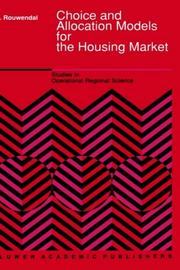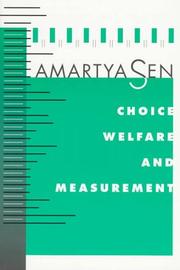Book
Year: 1970 Publisher: Paris: Gauthier-Villars,
Abstract | Keywords | Export | Availability | Bookmark
 Loading...
Loading...Choose an application
- Reference Manager
- EndNote
- RefWorks (Direct export to RefWorks)
Prices --- Production functions (Economic theory) --- Utility theory
Book
ISBN: 3540542477 9783540542476 Year: 1991 Publisher: Berlin : Springer,
Abstract | Keywords | Export | Availability | Bookmark
 Loading...
Loading...Choose an application
- Reference Manager
- EndNote
- RefWorks (Direct export to RefWorks)
Utility theory --- Probabilities --- Risk --- Economics, Mathematical
Book
ISBN: 9780333662601 0333662601 Year: 1997 Publisher: London: MacMillan,
Abstract | Keywords | Export | Availability | Bookmark
 Loading...
Loading...Choose an application
- Reference Manager
- EndNote
- RefWorks (Direct export to RefWorks)
Decision making --- Utility theory --- Game theory --- Risk

ISBN: 0792304667 9780792304661 Year: 1989 Publisher: Dordrecht: Kluwer Academic Publishers,
Abstract | Keywords | Export | Availability | Bookmark
 Loading...
Loading...Choose an application
- Reference Manager
- EndNote
- RefWorks (Direct export to RefWorks)
Book
ISBN: 0801835984 Year: 1988 Publisher: Baltimore (Md.) : Johns Hopkins university press,
Abstract | Keywords | Export | Availability | Bookmark
 Loading...
Loading...Choose an application
- Reference Manager
- EndNote
- RefWorks (Direct export to RefWorks)
Decision making. --- Game theory. --- Uncertainty. --- Utility theory.
Book
Year: 1975 Volume: 113 Publisher: Berlin,New York : Springer-Verlag,
Abstract | Keywords | Export | Availability | Bookmark
 Loading...
Loading...Choose an application
- Reference Manager
- EndNote
- RefWorks (Direct export to RefWorks)
Matrices --- Utility theory --- Matrices --- Utilité (Economie politique)
Book
Year: 1998 Publisher: Cambridge, Mass. National Bureau of Economic Research
Abstract | Keywords | Export | Availability | Bookmark
 Loading...
Loading...Choose an application
- Reference Manager
- EndNote
- RefWorks (Direct export to RefWorks)
Many industries are characterized by heterogeneous objectives on the part of firm owners. Owners of private firms, in particular, are likely to maximize utility, rather than profits. In this paper, we model and measure motivations of owners in on particular industry, the California wine industry. In both a formal model and an empirical analysis, we examine the implications of these motivations for market behavior. We find evidence that owners with strong non-financial motivations choose higher prices for their wines, controlling for quality; owners with strong profit-maximizing motives choose lower prices for their wines, controlling for quality. We also find that utility-maximizers are more likely to locate at the higher end of the quality spectrum, whereas profit-maximizers are more likely to locate at the lower end. We explore how the presence of a significant number of utility maximizers within an industry affects the competitive interactions within that industry. We conclude that some winery owners consume' features of their product or business as a substitute for profits and, in the process, provide softer price competition for for-profits. Additionally, in aggregate, their preference for quality can prevent entry into the high-quality segment on the part of profit-maximizing firms.
Book
Abstract | Keywords | Export | Availability | Bookmark
 Loading...
Loading...Choose an application
- Reference Manager
- EndNote
- RefWorks (Direct export to RefWorks)
Basu and Ray use the collective model of the household and show, theoretically, that as the woman's power rises, child labor will initially fall, but beyond a point it will tend to rise again. A household with a balanced power structure between the husband and the wife is least likely to send its children to work. An empirical test of this relationship using data from Nepal strongly corroborates the theoretical hypothesis. This paper-a product of the Office of the Senior Vice President, Development Economics-is part of a larger effort in the Bank to understand how gender affects development outcomes and to identify the causes of poverty. The authors may be contacted at kbasu@mit.edu or ranjan.ray@utas.edu.au.

ISBN: 0674127781 Year: 1998 Publisher: Cambridge (Mass.): Harvard university press
Abstract | Keywords | Export | Availability | Bookmark
 Loading...
Loading...Choose an application
- Reference Manager
- EndNote
- RefWorks (Direct export to RefWorks)
Book
Year: 1977 Publisher: Cambridge, Mass. National Bureau of Economic Research
Abstract | Keywords | Export | Availability | Bookmark
 Loading...
Loading...Choose an application
- Reference Manager
- EndNote
- RefWorks (Direct export to RefWorks)
The Austrian theory of the "marginal use" is restated and extended. It is found that the Austrian concept of marginal utility (as derived from the marginal use) is not dependent on cardinal utility, and indeed is consistent with "intrinsically ordinal" utility. In this system, diminishing (ordinal) marginal utility is an implication of rational choice, rather than an assumption. Examples of the rank-ordering on commodity space, derived from the underlying rank ordering on want-set space in conjunction with the technological relationship between goods and wants, are given in the cases of independent, rival, and complementary goods. In each case the derived commodity preferences are quasi-concave, which suggests that the Hicksian assumption of quasi-concavity is superfluous. In each case, the Auspitz and Lieben-Edgeworth-Pareto criterion for net complementarity or rivalness emerges. It is shown that while a negative cross substitution elasticity is not a necessary condition for net complementarity, it is a sufficient condition under not very restrictive conditions.
Marginal utility. --- Utility theory --- Mathematical models.

 Search
Search Feedback
Feedback About UniCat
About UniCat  Help
Help News
News